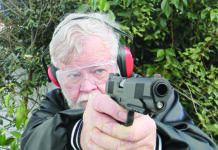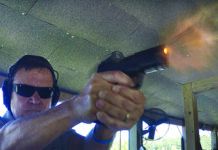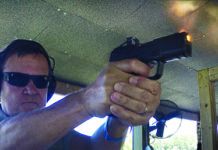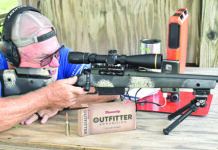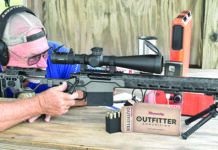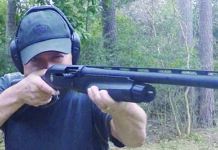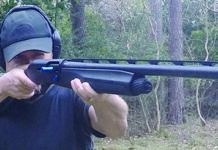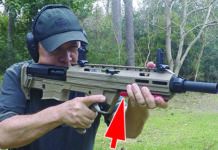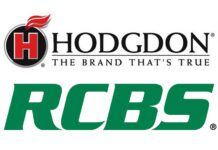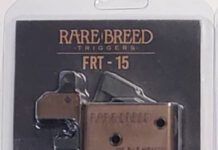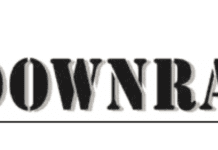Cowboy Action shooters might well consider choosing a .38 Special for their activities if they have even the slightest trouble with recoil from the .45s. Recoil recovery plays a big part in Cowboy competition, speed being mighty important for best scores. Gun Tests tested the American Western Arms Ultimate 1873, all blued, for $600. It had 5.5-inch barrels, and was made by Pietta in Italy. Here’s what they found.
On all versions of this single action, the frame is forged and the barrel is hammer forged. Options include a variety of chamberings, and either nickel or hard-chrome finish for $195 over the base price. There is also a Bisley version in .45 or .357. The Classic version uses a traditional flat hammer spring and costs only $440 in all-blue, or $565 with real case hardening. This Ultimate had a coil hammer spring. More on it later.
Metal polishing on the gun was excellent, giving a glossy look to the bluing. The gun was made in Italy by Pietta, a company which has pleased the test staff with other importer’s guns. The AWA had its model name on the barrel. Good luck trying to read it in normal light, but that’s all good if you want your AWA to look like a cowboy gun, not one with all sorts of useless information embarrassingly embossed into the barrel, as found on some other prominent-make sixguns.
Workmanship was excellent throughout, they thought. All the controls were very Colt-like. The construction of the AWA was entirely as was done on early Colts, even to the full-length cylinder-pin bushing, the beveling on the fronts of the chambers, and the curved-bottom trigger guard. This gun was in fact set up to be just like early revolvers, load only five shots unless you’re in a gunfight and keep the hammer down on the empty chamber. The hammer held the loosely fitted firing pin via a cross pin, just like in days of old.
The gun was fitted with decent one-piece walnut grips. The inletting was exemplary, but the wood finish was dull and lackluster. A good rubbing with linseed oil would help, they thought. However, the rear edges of the wood were much too sharp. The sharp edge stung the hands with hot loads. Sandpaper would fix this.
In the examination of this six-shooter they found an odd situation. If the hammer was cocked with the cylinder out of the frame, the hammer could not be lowered unless you knew the trick. The trick is to press the cylinder hand rearward, and then the hammer can be lowered.
The only fault they could find on this gun with its mechanism was one shared by many an old Colt: the cylinder-release button unscrewed and fell out of the frame. They found all three parts and put it back together. A touch of Loctite would fix this, but the maker needs to do it, they felt, not the owner. They lucked out that the parts, including the tiny spring, fell out in the office and not in the field. This is something every owner of a single-action Colt or any of its clones needs to be aware of. But even if you do lose all the parts the gun will still fire, one of the beauties of the old Colt design.
On the range they found another minor problem, though it was not accuracy, which was mostly fine with the test ammunition. We tested with Black Hills cowboy loads, a similar handload, Federal Hi-Shok 125-grain JHP .357 Magnum, and with Winchester SXT .38 Special 130-grain JHP. With cowboy-level loads the hits at 15 yards were about 2 inches low and 3 inches left. With the hot .357 ammo, the strike was worse, 4 inches low and 6 inches left. Accuracy with the .357 fodder was not good, and the blow-by and blast were so bad that they discontinued testing with it. There is no reason to test ammo that is useless, they figured, and if you can’t get close enough to where you’re aiming, the ammo/gun combination is useless.
The off-center hits would be a big problem for some, but other shooters would feel that windage misalignment would be normal for general cowboy-action shooting. The low strikes would not be much of a problem. The front sight presented a round-topped post to the shooter, which could be filed flat to give a better picture and raise the impact. The rear sight was a U-shaped notch of good width. But there’s no easy way to get the hits in line with the center of the target.
Gun Tests liked this gun, though most of the testers said they would have spent the extra money for case coloring, which is done by Doug Turnbull. This AWA had a superb, clean trigger pull of 3.5 pounds. Its controls and operations were all true Colt-like, but the hammer action was like that of a finely tuned custom Colt. The accuracy was in the two-inch-or-better range, with many four-shot clusters around an inch or smaller, which they figured was plenty good enough for lots of fun shooting. The complaints were solely about the overall look of an all-blued gun, which they didn’t like, and in the off-center zeroing, which may or may not make a difference to you. The gun didn’t seem to lend itself to general use with hot .357 Magnum ammunition because it shot even farther off the mark. A dedicated shooter could fix that, but Gun Tests believes cowboy-action shooters would be better served to stick with .38 Special cowboy-level loads, which worked well.



